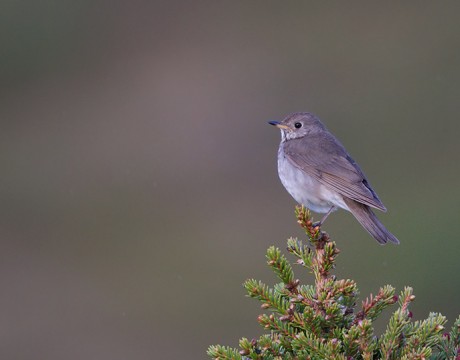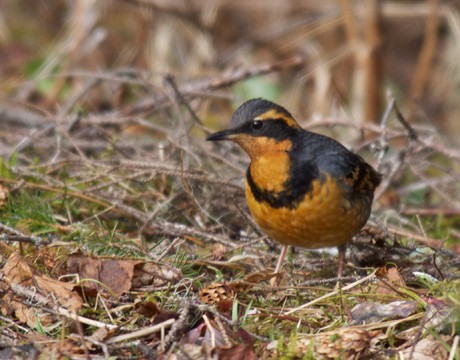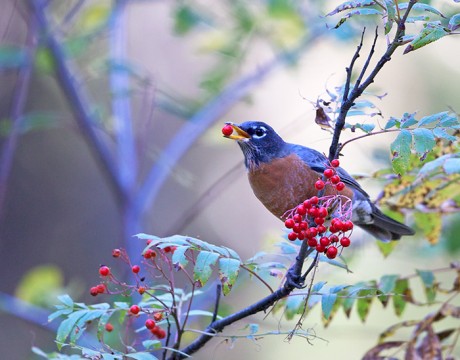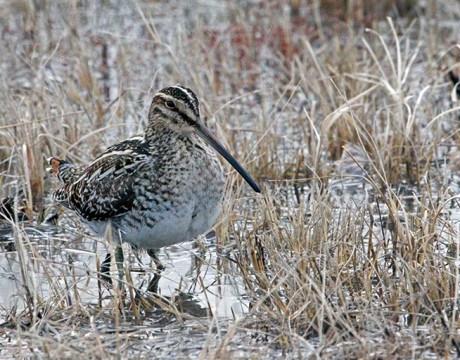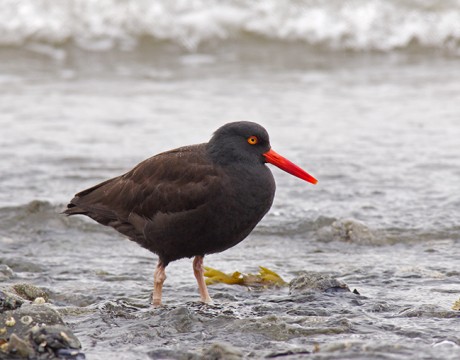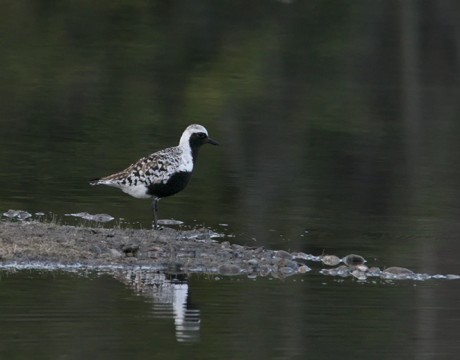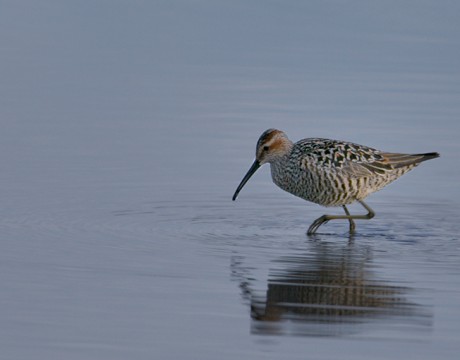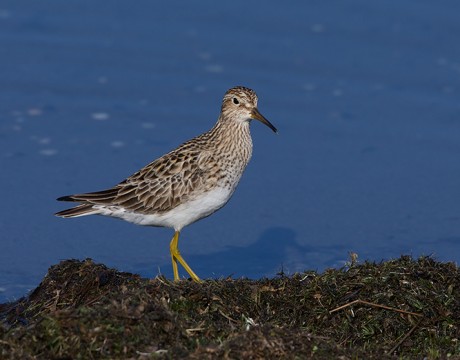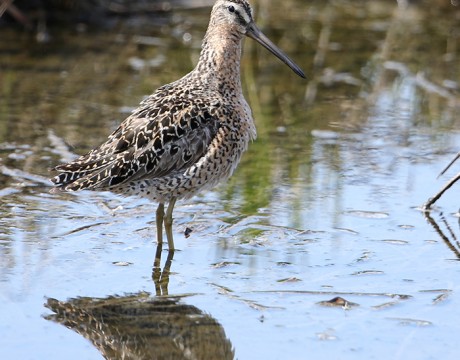Bird of the Week – Grey-cheeked Thrush
Another bird that visits Alaska to breed, prefering brushy habitats. WC has seen it most often near tree line in near-alpine country. Very shy and elusive, except during the start of breeding season when the males sing from the tops of bushes and the dwarf spruce. This might be the least-studied North American thrush. Except by range and song, it can be tough to distinguish from its cousin, the Bicknell’s Thrush. The song is lovely, flute-like and burry, rising in the middle and then ending on a downward slur. Another of WC’s favorites in alpine terrain. Camera geek stuff: f5.6,…
Bird of the Week – Varied Thrush
The sad, burry song of the Varied Thrush haunts the western Boreal forest. You will hear this species more often than you see it, but its dramatic orange and black plumage make it distinctive. It’s slightly smaller than a Robin, with a similar orange breast, but the black mask and “necklace” make it impossible to confuse the two. Varied Thrush prefer mature spruce forests; they are a species of concern because of habitat loss. Camera geek stuff: f5.7, 1/250, ISO250 For more bird photos, please visit Frozen Feather Images.
Bird of the Week – American Robin
Even birders get tired of shorebirds. Let’s switch to thrushes. And by far the most common and the largest thrush in North America is the American Robin. WC has seen American Robins on the north side of the Brooks Range, in Nome, in the Yukon Delta, in Valdez and in Hyder, as well as all points in between. It’s also a species that adapts well to human-altered terrain. This fellow is showing feather wear; he’s likely about to molt into fresh chest feathers. The Robin’s song is one of WC’s favorite signs of spring. Camera geek stuff: f4, 1/400, ISO500,…
Bird of the Week – Wilson’s Snipe
Any guy who ever went to camp likely went on a Snipe Hunt. For those who never did, it’s a mild form of hazing, involving pillow cases, expeditions in the dark and getting left in the woods to feel foolish. So it may comes as surprise to learn there is such a thing as a snipe. Specifically, Wilson’s Snipe. This is a bird that is heard much more often than it is seen. Snipe courtship involves “winnowing,” a spectacular courtship flight, during which individuals produce a haunting, tremulous sound (the winnow) with their outspread outer tail-feathers. It is “produced by airflow…
Bird of the Week – Black Oystercatcher
About 15 years ago now, WC was in Valdez to start a Birdathon – in fact, a record-making Birdathon – when he encountered a drunken fisherman on the docks of the small boat harbor in Valdez, Alaska. The guy saw the binoculars and was able to conclude we were birders. “Yeah,” he slurred, “We just saw a Double-crested Oystercracker.” Which was probably a Black Oystercatcher. That’s a bird bill to remember, WC thinks you will agree. This is a true shorebird, spending its entire life along the rocky shores of the Pacific Ocean, found from the Aleutian Islands to Baja…
Bird of the Week – Black-bellied Plover
Oh Lordie, another shore bird? Yep. There’s a lot of them. At least this one has a name that makes sense, even if it only makes sense in breeding season. The European name for this species, Gray Plover, fits a lot better in non-breeding plumage, but WC doesn’t have a photo of a bird in non-breeding plumage. This handsome plover breeds along Arctic coastal Alaska and Canada, and in the Yukon Delta. It winters along both the Atlantic and Pacific coasts of North America. Camera geek stuff: f13, 1/500, ISO6400. For more bird photos, please visit Frozen Feather Images.
Bird of the Week – Stilt Sandpiper
Crikey, is there ever an end to these shore birds? Not yet. This week we have a mediocre photo of a fairly uncommon species in interior Alaska, the Stilt Sandpiper. The heavy barring and the reddish patch behind and below the eye distinguish this species from it cousins. The species breeds exclusively on the Arctic coast, east of Pt. Barrow. It winters on the Gulf of Mexico and down through Mexico and Central America. The origin of its name is a bit obscure; its legs aren’t appreciably longer than other sandpipers. Unless you are on the Beaufort Sea, you aren’t…
Bird of the Week – Pectoral Sandpiper
WC warned you there are lots of shorebirds in Alaska. Here’s another. The Pectoral Sandpiper passes through in migration en route to coastal areas for breeding. The distinctive, abrupt change from heavy streaking to pure white in the middle of the chest is a pretty good field mark. The male has an inflatable throat sac, which expands and contracts rhythmically during his display flights. The resulting vocalization is a series of hollow hoots, and is one of the most unusual sounds heard in summer on arctic tundra. This species winters on the pampas of Argentina, a remarkable migration, as much as 30,000…
Bird of the Week – Long-billed Dowitcher
A handsome, chunky shore bird with an impressive bill, the Long-billed Dowitcher is found throughout most of Alaska in migration, breeds on the wester coast and is very easily confused with its Short-billed cousin. Dowitchers forage with a rapid up and down motion, probing with their bill, like a frenzied sewing machine. It’s very distinctive. They are seen most often in the spring, during migration. It can be pretty tough to tell Long-billed from Short-billed Dowitchers in the field. The Long-billed has a bill length more than twice the thickness of the bird’s head; the Short-billed isn’t quite so magnificent….
Bird of the Week – Greater Yellowlegs
Happily, the range of the Greater and Lesser Yellowlegs rarely overlap in Alaska. If you see the bird in Southcentral or Southeastern Alaska, it’s probably a Greater Yellowlegs. The Greater is, as the label suggests, somewhat larger than the Lesser Yellowlegs, but unless you have them side-by-side, it’s hard to tell. The bill is significantly longer in the Greater, longer than the head, which sometimes helps. The call is very different, but the Greaters aren’t quite as vocal as the Lessers. But if birding were easy, if telling Lessers from Greaters were easy, it wouldn’t be as much fun. Camera…





